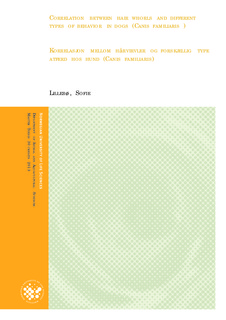| dc.description.abstract | Abstract
Dogs are very popular pets and it would be useful to find more tools to better understand their behavior. Reactivity can be seen as emotionality, and indicate a heightened state of arousal. So the aim of this study is to investigate the possible links between numbers and directions of hair whorls according to reactivity in dogs, with focus on the dogs’ chest, and upper part of the left and right leg (shoulders).
A quantitative research method was used with a questionnaire (containing Negative scale, Positive scale and Questionnaire1 scale of reactivity trait) distributed in two countries; Nor-way and Hungary. To validate the questionnaire a direct observation test was conducted to correlate the owners’ view of the dogs’ behavior to an observers view.
Comparing samples from the two countries there was a similar range of male and female dogs, the same range of age, and similar direction of the chest hair whorls, but hair whorls direction and numbers on the legs were different. There was also a difference between countries in the Negative scale and Questionnaire1 scale score and in breed composition. The several differences between the Hungarian and Norwegian sample can indicate cultural differences, but also that the variation of breeds could have an effect on the results.
There was no effect of sex on behavior scale scores in the Norwegian sample or the Hungarian sample. But there was a weak negative correlation between age and the Positive scale score in the Norwegian sample and a medium negative correlation between age and the scale scores in the Questionnaire1 and Positive scale in the Hungarian sample.
There were few indications that the owner and observer had the same view of the dogs behavior, but that can be due to the fact that dogs might have another behavior in a research situation than in an everyday situation. 20-25 % of owners commented that it was either difficult or very difficult to find the hair whorls. These results can indicate that a questionnaire is not the proper tool for assessing the link between behavior and hair whorl characteristics.
When correlating hair whorls characteristics and the dogs’ behavior, the second counter-clockwise hair whorl and multiple whorls were related to the Positive scale score in the Nor-wegian sample. This can indicate that there is a connection between several whorls and a counterclockwise direction of hair whorls to a higher state of energy and excitability. | no_NO |
